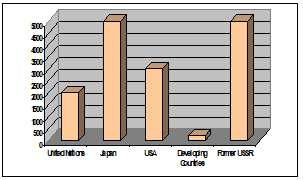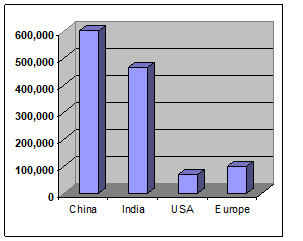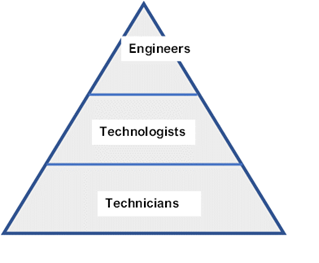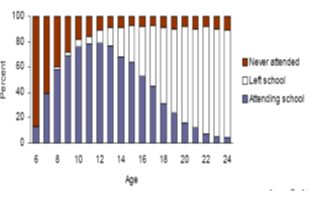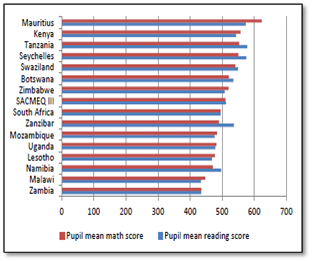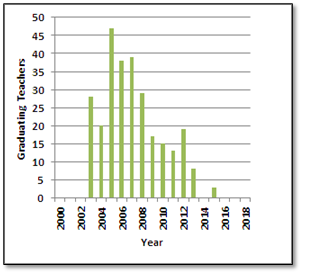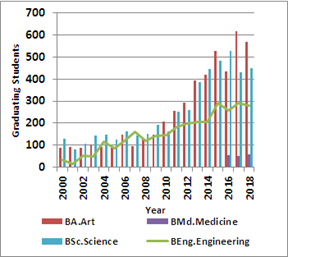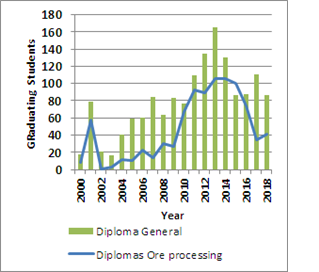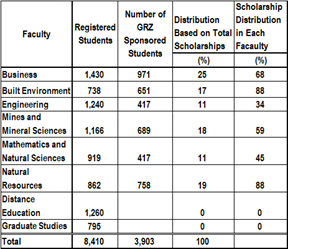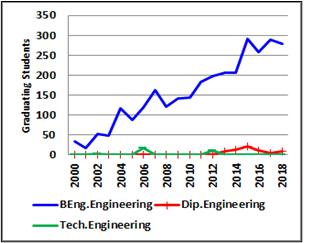An Evaluation on the Relevance of Engineering Education to Zambia’s Economic Development
- Cornwell Tepa
- Tinah Phiri
- Wilfred Mwenya
- 1567-1587
- Feb 16, 2023
- Education
An Evaluation on the Relevance of Engineering Education to Zambia’s Economic Development
Cornwell Tepa, Tinah Phiri and Wilfred Mwenya
Copperbelt University, Metallurgy Department, School of Mines and Mineral Science, Kitwe, Zambia
ABSTRACT
Zambia’s development goals are targeted at alleviation of poverty through the implementation of socio-economic reforms using various economic strategies focusing on measures aimed at achieving strong sustained economic growth and development in all sectors of the economy.
A key aspect of a development strategy designed to bring about economic development in a peripheral economy like that of Zambia is the improvement of competitiveness through closing the technological gap between it and the more advanced economies of the world.
One of the most important ways of closing the development gap is through the transfer or acquisition of modern competitive technologies and/or the generation of these through the appropriate mobilization of indigenous resources. However, this is critically dependent on adding value to the local human resource mainly through the third-level educational institutions or institutions of higher learning who offer engineering education.
The dominant objective of engineering education is to satisfy the need for skilled technical workers and providing the required critical mass of engineering manpower for domestication of competitive technologies. This paper examines challenges faced in improving delivery of engineering education in Zambia with the view of providing a direction for remedial measures to be taken in addressing the situation. The bulk of the observations are based on the Copperbelt University as a typical representative third level higher institution of learning which was established with faculties of engineering to satisfy labour demands for the mining and manufacturing industry in Zambia.
Keywords: Engineering Education, Technology Transfer, Higher Education, Engineering Manpower.
INTRODUCTION
Zambia is signatory to the Millennium Declaration of 2000, made at the Millennium Summit in which countries agreed to dedicate their efforts to overcoming human development challenges. In accordance with these declarations Zambia’s development goals are targeted at alleviation of poverty through the implementation of socio-economic reforms under such instruments as the Poverty Reduction Strategy Paper (PRSP) and Transitional National Development Plan (TNDP). Currently over 80% of the people out of the total population of over 17 million live below the poverty datum line and subject to poverty, hunger and other forms of deprivations. Zambia’s PRSP focuses on measures aimed at achieving strong sustained economic growth and development in all sectors of the economy. It is worth noting that the single greatest manifestation of the failure of economic policies in a country is high unemployment rate. Therefore, the success of these strategies will be judged by the extent to which the high unemployment rate will be reduced.
Importance of Science and Technology to Economic Development
For a long time, the issue of importance of science and technology for economic development has been discussed extensively at different forums, by scientists, engineers, politicians and ordinary citizens from different organizations. In addition, over the last thirty years, the heads of various African scientific institutions have been stressing the importance of rapid industrialization and the role science and technological development can play in increasing the national output, and contributing to dynamic and self–reliant economies. However, with the dawn of the 21st century the continent continues to lag further behind global trends particularly those of the newly industrialized economies of the Pacific Rim such as South Korea, Taiwan, Hong Kong and Malaysia which have utilized technology for rapid economic growth and increased prosperity for their people.
On the other hand, Africa continue to be plagued by civil wars, internal conflicts, drought and desertification, political instability and the problem of refugees, deteriorating health infrastructures exacerbated by the AIDS/HIV pandemic, mounting external debt and a pervasive crisis of poverty among its people.
The role of science and technology is crucial if a nation is to take its development into its own hands and avoid the risk of marginalization. Countries that have benefited from science and technology have been able to take timely decisions to use science and technology in the production of goods and services not only to compete on the international market but also to improve the standard of living of their people. This has led to the desire of most under developed countries to move into frontiers of science and technology an area in which there is a high dependency on European and North American countries.
Generally, issues related to underdevelopment can be attributed to a number of factors which include the following
- Lack of natural resource potential: a country may not be richly endowed with natural resources for exploitation to generate wealth.
- Lack of capacity: a country may have a natural resource potential but lacks the capacity to exploit the natural resources to generate wealth.
- Lack of political will and direction: a country may have potential and the ability to exploit the natural resources to generate wealth but lacks the political will and direction to manage both human and natural resources for economic development. In Africa and Zambia in particular, the blame for stagnated economies is squarely pinned on African leaders, not only for lack of political will but also for failure to diversify and broaden the base of their economies, and for the rapid rise in unemployment and the potentially dangerous fiscal and domestic debt situations. The economic problems are to a large extent the consequence of a combination of inappropriate policies, weak policy implementation and infrastructural and institutional decay.
- Technology gap: The structure of the world economy has generated a technological gap between the developed economies and third world countries in a manner that disadvantages the latter. This has confined the role of developing economies to generate and supplying raw materials and primary commodities to manufacturing industries in the developed economies who produce finished products for creation of their own wealth.
The resultant effect of these factors is economic stagnation in developing countries.
Development Strategy
In view of the foregoing, a key aspect of a development strategy designed to raise the living standards and promote employment opportunities in a peripheral economy like that of Zambia and other developing countries, is the improvement of competitiveness through closing the technological gap between it and the more advanced economies of the world.
One possible way of closing the development gap is through the transfer or acquisition of modern competitive technologies and/or the generation of these through the appropriate mobilization of indigenous resources. This however, adds another dimension to the development strategy namely, the building up of the indigenous capacity of the local economy to domesticate competitive technologies. This is critically dependent on adding value to the local human resource mainly through the third-level educational institutions or institutions of higher learning. The emphasis on adding value to the local human resource mainly through institutions of higher learning should be based on improving engineering education through which a technologically competent engineering workforce is produced. This is premised on the proven fact that domestication of competitive technologies is largely dependant on the education and skills of the engineering workforce who are also the key competitive weapon in international trade.
Engineering Education and Sustainability of MDG based strategies
If development instruments such as the Poverty Reduction Strategy Paper (PRSP) and Transitional National Development Plan (TNDP), does not take into account this aspect of economic development that prioritizes domestication of appropriate competitive technologies by adding value to the engineering workforce, attempts to achieve the Millennium Development Goals (MDGs) may prove difficult to attain.
Sustainable MDG-based strategies require the building up of indigenous institutions and skills to advance science, technology, and innovation. Practical measures to increase a country’s scientific capacity include, expanding science and engineering faculties in universities and polytechnics, strengthening development and entrepreneurial focus in science and technology curricula, promoting business opportunities in science and technology, and promoting infrastructure development as a technology learning process.
The MDGs were targeted to be achieved by 2015. However, the United Nations update report (UN Millenium Project, 2005) indicate that, although the world has made significant progress in achieving many of the MDGs, progress has been far from uniform across the world-or across the Goals.
Sub-Saharan Africa, where Zambia is located, is the epicenter of this crisis, with continuing food insecurity, a rise of extreme poverty, stunningly high child and maternal mortality, and large numbers of people under poor living conditions and a widespread shortfall for most of the MDGs (UN Millenium Project, 2005)
The standard diagnosis of Sub-Saharan Africa to account for failure to achieve most the MGDs has been attributed to governance crisis in the respective countries as already outlined. However, this may not be entirely true as many parts of Africa are well governed considering the income levels and extent of poverty, yet are caught in a poverty trap. The region’s development challenges are much deeper than “governance” and largely attributable to lack of capacity to use science and technology for economic development. Many countries require a big push in public investments to overcome, among other things, slow diffusion of technology from developed economies (UN Millenium Project, 2005) and the subsequent domestication of such technologies requires adding value to the engineering workforce by improving the delivery of engineering education in higher institutions of learning.
HIGHER EDUCATION
The term “Higher Education” encompasses various forms of educational institutions beyond the secondary school level. These include the conventional universities which offer courses in both science and humanities, engineering polytechnics which provides advanced vocational training; professional schools such as management or public administrative schools. In Zambia, higher education institutions include the University of Zambia, the Copperbelt University, Mulungushi University and the public universities recently converted from teaching colleges, namely; Nkwame Nkhrumah University, Mukuba University, Chilimbana University, and Palabana University; and teachers or education colleges and medical schools. The technical and vocational colleges under Technical Education and Vocational Entrepreneurship Training Authority (TEVETA) were designed to impart skills and expertise to students for application in the various sectors of their professional engagement. It is through these institutions that a critical mass of engineering and scientific talent can be achieved.
The University of Zambia and the Copperbelt University are the only institutions in Zambia with engineering faculties running programmes up to postgraduate level. It is important to note that the bulk of the observations referred to in some of the discussions presented in this paper are based on data collected on the Copperbelt University. Copperbelt University represents a typical third level institution of higher learning which was established to run engineering programmes ranging from advanced certificates to degree programmes as well as business studies. Mining related programmes, ranging from advanced technician to diploma level, such as Mining Ventilation, Mining Survey, Mine Metallurgy, Mining Engineering and Chemical Technology, mainly devoted to supporting the Zambia’s mining industry, are only specific to the Copperbelt University. Consequently, comparative data with other local institutions is rare. In line with the theme in this paper, the observations drawn, does to a greater extent, not only provides a general direction to the broader spectrum of higher institutions of learning in Zambia to improve the delivery of engineering education but is also pertinent to support discussions on the subject matter.
Reasons for the Establishment of Higher Education in Africa
In comparison to setting up universities in advanced economies, the hopes and aspirations that led to the creation of African universities had expectations that these institutions would act as key players in wealth creation and national development. The founding fathers, who led the liberation struggle for political emancipation, had in mind that economic liberation would be achieved to a greater extent by establishing institutions of higher learning that would play a dynamic role in the process of national building and generation of development. It was the latter image of the university as a factor of development that become more dominant and led governments to provide increasingly larger funds for higher education at the expense of expanding primary school facilities (Ramphal, 1979).
In view of a university being a factor of development, an African university is expected to be more than an institution for teaching, research and dissemination of higher learning. It is expected be accountable to and serve the vast majority of the people. It must be committed to active participation in the social transformation, economic modernization and exploitation of resources of the nation. (Yesufu, 1973).
A timely illustration is a comparison of role of tertiary education in economic development between two copper mining dependent economies, Zambia and Chile. In 1969, Chile’s large scale mining industry had a labour force of around 17,000 which included approximately 1% expatriate technical staff. In the same year the Zambian mining industry had 43,500 local employees and 4,727 expatriates accounting for 10% of the total number of employees (Twenty seven times Chile’s expatriate labour force). Chile had seven long established universities, some of them with large science and engineering departments producing numerous Chilean engineers (De Vletter, 1972) compared to Zambia which had one faculty of engineering at the University of Zambia during the same period. The second faculty of engineering was created 20 years later as a result of transforming, the Zambia Institute of Technology (ZIT) into the School of Technology under the Copperbelt University in 1989. The creation of large science and engineering departments producing numerous Chilean engineers had a definite impact on improving the technological capacity of the local economy. Currently, Chile is much more advanced in science and technology than Zambia largely because of utilizing its indigenous engineers. By 2000, Chile had tremendously improved its mining technology and producing its copper at a cost of 45c/lb far below the minimum requirement of 50c/lb compared to Zambia which was producing its copper for most part at a cost of 80c/lb, a condition which proved to be economically unfavorable especially when the trend of copper prices began to decline. It is for this very reason that early in the year 2002, Anglo American Corporation (AAC), a long time shareholder in ZCCM, finally decided to pull out of Konkola Copper Mines just 18 months after it had reinvested in the company after privatization of ZCCM. It gave as its main reason high costs of production and losses incurred from low copper prices on the foreign market. AAC subsequently re-invested its money in the Chilean mining Industry. (Sikamo et al, 2016). In the early ‘90s, Chile had the perfect climate for economic prosperity, one in which the mining sector played a significant role. The natural resource export model, combined with institutional and political reforms, allowed the economy to make an unprecedented jump onto the world stage. As a direct result of the changes, by 2016, less than a third of the population was below the poverty line, income quadrupled and Chile became one of the two high-income Latin American economies (International Copper Association, 2017). This illustration is a demonstration of how institutions of higher learning can impact a country’s competitive advantage over others as a result of improving its technological capacity.
TECHNOLOGY TRANSFER AND ENGINEERING MANPOWER
Technology transfer is defined as the flow of ideas, discoveries and inventions into a widely adopted and usable form. It is the commercial exploitation of information and ideas emanating from the public research systems such as universities and government research laboratories (Faulkner et al, 1988). It is also includes the slow diffusion of technology from developed economies.
The impact of transfer of technology is largely dependent on the capability of indigenous human resource to domesticate such technologies. The development of engineering manpower is crucial in the acquisition, utilization and maintenance of acquired technology. Research organizations will develop new technologies, but applying these technologies to create innovative products and processes will depend on the education and skills of the engineers. Therefore, the work force, on the engineering and manufacturing floors, are the key competitive weapons in closing the technology gap with advanced economies. It is on account of this realization that necessitates improving engineering education in the broader context of advancing science and technology for economic development.
BUILDING OF INDIGENOUS TECHNOLOGICAL CAPACITY
The Chilean case as discussed above proves that building up the indigenous technological capacity can improve the competitive advantage of a country in international trade. The following factors should be considered in the building up of the local technological capacity.
Critical Mass of Engineering Manpower
The United Nations considers that a number of 2,000 scientists and engineers per million population is a good guide. Japan has nearly 5,000, the U.S.A. has 5,000 scientists and engineers per million population (UNESCO Press, 1994). In contrast, it is estimated that there is an average of about 200 engineers per million population in developing countries (Figure 1)
Figure 1: Number of Scientists and Engineers per Million
Figure 2: Number of Engineering Graduates per Year
Figure 2 shows the number of engineering graduates produced per year for the USA, India, China and Europe.
China is today the largest producer of engineering graduates in the world, with some 600,000 passing out of its colleges and universities as an annual average (Type, 2006).
According to the All India Council for Technical Education, India produced 401,791 engineers in 2003-04, 35 per cent being computer engineers. In 2004-05, the number of engineering graduates increased to 464,743, of which 31 per cent were computer engineers.
Compared to India and China, the United States produces only 70,000 engineering graduates every year. All of Europe produces just 100,000. This partly explains why India and China are the fastest growing economies in the world. (Type, 2006). By comparison, the 200 engineers per million cited for third world economies is relatively inadequate to have an impact on the their economies.
Orientation of Engineering Graduates to the Local Economy
Provision of required number of engineering manpower does not provide a complete solution, but the quality and the relevance of engineering graduates to the local economy is even more important. For engineering education to become an effective avenue for economic development, engineering graduates should not only be produced for formal employment but should at the same time be equipped with entrepreneurial skills including the tools of management, finance and communication to set up and manage their own enterprises. In addition, the knowledge and the skills acquired should be relevant to design, development, construction, production etc., applicable to real life situations in the local economy. The university curricula, inevitably, requires constant review to meet the needs of the local economy.
Three Tier Structure of Engineering Manpower
For the engineering manpower to be effective in the delivery of technological solutions, it is necessary to structure it at three levels and should comprise of graduate engineers, technicians and technologists in proportions implied in the triangle in Figure 3. This is what obtains in economies where engineering education plays a significant role. The number of technicians should be largest followed by that of technologists and graduate engineers. Of all the three groups, the supportive group comprising of technicians is required in much greater numbers than professional engineers and scientists.
Figure 3: Three-Tier Structure of Engineering Manpower
In recognition of this fact, the aim of the International Fund for the Technological Development under the umbrella of UNESCO’S University – Industry Science Partnership program (UNISPAR) is to improve basic scientific and engineering skills in areas directly relevant to economies of African countries (Type, 2006).
In particular the shortage of technicians to support scientist and professional engineers was noted (Type, 2006). The setting up of the Zambia Institute of Technology (ZIT) in 1971 by the Zambian government and the subsequent transformation into the School of Technology under the Copperbelt University in 1989 was the recognition and realization of this fact. (Ministry of Higher Education Science and Technology, Internal Report, 1988). A similar pattern may also be observed in emerging economies like that of South Africa.
OBSTACLES TO BUILDING OF INDIGENOUS TECHNOLOGICAL CAPACITY
Obstacles to building of indigenous technological capacity are discussed broadly in terms of critical mass of engineering manpower, orientation of engineering graduates and Structure of Engineering Manpower.
Obstacles Related to Achieving a Critical Mass of Engineering Manpower
To raise the critical mass of engineering manpower, there is need to train more engineers, technologists and technicians to attain the levels cited for the Chinese and Japanese economies. Some of the obstacles in achieving the critical mass of engineering manpower in economies like of that Zambia are subsumed as follows:
High School Drop Out Rate at Primary and Secondary School Levels
In Zambia, eighty percent (80%) of students drop out at primary school level while the remaining 20% struggle through to secondary school. For those who drop out at grade 7, 9 and 12, their educational training does not include any practical skills. After 12 years within the educational system in their most formative years, the best the current educational system does with these school leavers is to prepare them to become street traders, victims of political manipulation and indulge in peace threatening activities (Mbikusita, 1990).
In 2015, the government introduced vocational streams in secondary schools to impart skills starting in grade 8. However, this intervention has been faced with numerous challenges due to non-availability of training equipment and suitably qualified skills training teachers and its success is yet to be realized (Zambia Education Curriculum Framework report, 2013). In particular, teachers with IT qualifications were not available. However, there has been a steady increase in the number of trainers with IT qualifications.
Figure 4 below shows the dropout rate according to age. By 19 years most pupils finish secondary school and from the graph only 20% would be finishing secondary school. By age of 23 years less than 10% are enrolled in tertiary education.
The high dropout rate in schools at both primary and secondary school levels subsequently contribute to the diminishing number of entrants into the engineering careers.
Figure 4: Schooling Status of Youth Ages 6-24, 1996
(Source: Zambia DHS, EdData, Educational Profile 1996)
Poor Background in Mathematics and Science
An extensive study was carried out by the Copperbelt University in 2004 to investigate and identify factors responsible for poor academic performance at the institution (Copperbelt University, Internal Report, 2004). In this study statistical software tools were used on student records for the period from 1998 to 2003 to correlate grade 12 results with performance of the students in different programs across faculties. The evaluation was conducted in terms of three determinants consisting of clusters of grade 12 subjects namely; Science-Mathematics Ability Factor, Verbal-Ability Factor and Memory-Ability Factor. Quantification of these Ability Factors was used as a measure of performance of students in the cluster of grade 12 subjects for each factor. The cluster of subjects for the Ability Factors were; Science-Mathematics Ability Factor (Physics, Chemistry, Mathematics and Additional Mathematics), Verbal-Ability Factor (English and Biology) and Memory-Ability Factor (Biology, History and English). For instance, student with a high Science-Mathematics Ability Factor performed well in Physics, Chemistry, Mathematics and Additional Mathematics subjects in grade 12.
The study revealed that students who did well in mathematics and science in their grade 12 examinations (a high Science-Mathematics Ability Factor) exhibited good performance in all university programs especially for engineering disciplines such as electronics, electrical, mechanical and chemical engineering. This, therefore, indicates that students with a poor background in mathematics and science are most unlikely to perform well in their university studies, especially in engineering disciplines. Poor background in mathematics and science, which has been evident with entrants into university has its genesis to the government’s decision to transform primary schools to middle basic schools to increase access to secondary school education up to junior level. The Zambian education system has a 7-5-4 structure, namely 7 years at primary school, The first 2 years of secondary school are spent at middle schools and 3 years at higher secondary school the end of which they must write a transitional selection examination. Upon successful completion of secondary school, pupils may choose to further their education by attending tertiary education either at a university, college, vocational or technical institute. Thereafter, they may spend 4 or 5 years in an academic environment, where, in case of undergraduate engineering training, they hope to reach the standard required to graduate as an engineer. However, the transformation of primary schools to middle basic schools during the educational reforms of 1977 (Mumba, 2019) was not accompanied by a corresponding training to upgrade primary school teachers, who were mostly holders of primary school certificates, to teach secondary school subjects including mathematics and science. This had a ripple effect on the performance of pupils for the rest of the secondary training and higher education. In fact the problem is traced back to primary school level. In a report (Moono, and Rankin, 2013) the Southern and Eastern Africa Consortium for Monitoring Educational Quality (SACMEQ) has been monitoring educational performance at the primary school level throughout the region since 1995. In the latest round of SACMEQ tests, undertaken in 2007, Zambian grade 6 pupils performed, on average, the worst in both mathematics and reading among the 15 countries. (Figure 5)
Figure 5: Average Performance of Grade 6 Pupils in Maths and Reading in Southern and Eastern Africa
(Source: Southern and Eastern Africa Consortium for Monitoring Educational Quality, various reports. cited in (Moono and Rankin, 2013)
It is a known fact that most of the middle basic and high schools in Zambia do not adequately teach mathematics and science. In a study assessing the performance of the grade 12 students in Kitwe district of Zambia, Copperbelt province, with respect to O-Level examinations in Mathematics and Science subjects in selected secondary schools and its impact on the performance of student upon admission in the school of Engineering of the Copperbelt University (Kafata and Mbelwa, 2016) showed that poor results in “O” Level mathematics and science at grade 12 had a negative effect on student progression in the School of Engineering. As a result, an average grade 12 pupil is not well grounded in mathematics and science subjects which are critical determinants for good academic performance at tertiary level, according to this study. The report arising out of the study carried out by the Copperbelt University further established a strong correlation between a low mathematics-science ability factor of new entrants to the university and high attrition rate of students especially in engineering degree programs. This subsequently leads to a reduced output of engineering graduates. To reduce the impact of a high failure rate on output of graduates, the Copperbelt University has revised the rule that excludes poor performers and allows affected students to either repeat the year of study in which they failed or apply for re-admission after a year’s absence. This ensures a high retention of students on their programs and gives them an opportunity to complete their studies. Having recognized that one of the major factors responsible for poor performance in mathematics and science in middle basic schools is lack of competence by teachers (Siachifuwe, 2017), the Copperbelt University also introduced mathematics and science diploma and degree programs designed to upgrade the competency of certificate primary school teachers in teaching mathematics and science. This intervention yielded remarkable results in teacher performance in both middle basic and secondary schools. However this initiative was short lived due to lack of government support. Figure 6 shows that the number of graduating diploma Mathematics-Science teachers steadily increased with the first cohort graduating in 2003 but 4 years later the number of graduates started to decline and with last group graduating in 2015, the programme ceased to function.
Figure 6: Number of Graduating Primary School Teacher with Diploma in Mathematics and Science at the Copperbelt University
The main reason for the demise of this programme is that most teachers were on self-sponsorship and with the emergence of other universities offering higher qualifications than diploma certificates, mostly in non-science fields and at affordable fees, there was mass migration of prospecting students to other colleges and universities.
However, the negative impact of this development has been mitigated by the established of the School of Mathematics and Natural Sciences offering degree programmes in mathematics and natural sciences (biology, chemistry and physics). Although these degree programmes were available to all applicants including high school graduates, the mathematics science diploma was specifically targeted at primary school certificate holders to build their capacity in the middle basic schools with the view of improving the Science-Mathematics Ability Factor at an early stage. This is one of the programmes that the government could have offered scholarships to sustain it.
Low Student Enrolments in Engineering Disciplines
The number of applicants for university education in Zambia is growing every year. A large number of applicants meet the minimum conditions to qualify for university education. However, due to the inability of public universities to accommodate all eligible applicants, only a few are selected. Table 1 shows enrollment figures for the Copperbelt University from 1994 to 2003.
On average, out of the total number of applicants only 30% are selected and out of those selected only 40% finish their studies. Further, the enrolment of students to engineering careers is low compared to humanities and other non-science based careers, a case that is common in most African universities.
Such is the desire that most national governments in Africa have instituted policies to reverse the current trend in student enrolment in universities which show more enrolments of students in non-science-based subjects than in science-based subjects – a ratio of roughly 70:30 (AAU Report, 1994; UNDP Human Development Report, 1993).
Table 1: Typical Enrollment Statistics for Copperbelt University
| Year | No. of Applicants | Applicants Selected | Graduates |
| 1994 | * | 463 | 388 |
| 1995 | * | 462 | 403 |
| 1996 | * | 446 | 253 |
| 1997 | 2,754 | 606 | 301 |
| 1998 | 2,947 | 435 | 307 |
| 1999 | 3,276 | 973 | 375 |
| 2000 | 3,029 | 480 | 367 |
| 2001 | 2,586 | 1,092 | 397 |
| 2002 | 2,833 | 1,232 | 324 |
| 2003 | 3,276 | 1,201 | 346 |
| Total | 20,701 | 6,019 | 2,417 |
| Average | 2,957 | 860 | 345 |
The objective is to reverse the ratio to 60:40 in favor of the sciences in order to create a minimum critical mass of scientific talent to advance the work of science and technology. The above objective is difficult to attain depending on the institution. In case of Zambia and using Copperbelt University as a model for public universities offering engineering education, the high enrollment ratios of non-science-based to science based programmes is exemplified further in the sections that follow:
The Copperbelt University admits students using a cut-off point system based on a grading system for grade 12 ‘O’ level results. A distinction in a grade 12 subject is graded as ‘1’ while a fail is graded as ‘9’. Admission to university is based on the grades of five ‘O’ subjects with Mathematics and English as compulsory subjects followed by science subjects in the second place and lastly any other subjects to make a total of five ‘O’ level subjects. A highest grade 12 performance would have a total score of 5 points and the poorest performer would score 45 points. High achievers have a low cut-off point value while low achievers have a high cut-off point value. The lowest cut-off point for degree programmes is 15 below which (i.e. greater than 15 points) an applicant can only qualify for admission to diploma programs provided the admission criteria is met. Summary of admissions for the 2001 academic intake for selected programs at the Copperbelt University is shown in the Table 2.
Table 2: Summary of Admissions for 2001 Academic Year
| Programme | Cut of Point | Number of Admissions | Approved Quota |
| Electronics | 6 | 40 | 20 |
| Computer | 8 | 40 | 20 |
| Mechanical | 11 | 60 | 20 |
| Chemical | 12 | 50 | 20 |
| Metallurgy | 14 | 40 | 20 |
| Mining | 15 | 50 | 20 |
| Accountancy | 10 | 174 | 150 |
| Civil Engineering | 13 | 30 | 20 |
Comparison between admissions to engineering disciplines and the humanities like accountancy shows that for the same cut-off point the number of students admitted into accountancy is three times more. Some of the reasons to account for this are;
Firstly, the number of applicants admitted to non-science based careers is determined by classroom space, sufficient availability of study materials and computers while admission to engineering programmes is determined by laboratory space and availability of equipment for practical studies.
Secondly, the cut-off point for a program of study is determined by the level of demand or interest by the applicant for that particular program. From Table 2, the cut-off point for Mining Engineering, for instance, is 15 with a total number of 50 admitted while a non-engineering program, Accountancy, with a cut-off point of 10 admits nearly 180 students. With the establishment of the School of Medicine at the Copperbelt University, almost half of high achievers and three quarters of female applicants opt for a career in medicine. Since its inception in 2011, the cut-off point for School of Medicine has been the highest at 6 points. This indicates an increasing preference of new applicants to undertake careers outside engineering. Figure 7, shows the number of undergraduate students graduating from humanities, science, medical (represented by bars) and engineering faculties (represented by a curve). It is evident that there has been an exponential increase in the number of students graduating from non-engineering faculties compared to engineering.
Figure 7: Graduating Students from Various Faculties of the Copperbelt University, 2000-2018.
On the overall, low performing students (indicated by a high of cut-off point value) are being admitted into engineering disciplines while high flyers (indicated by a low value of cut-off point) are opting for non-engineering disciplines. This presents a major obstacle not only in attaining the required critical mass of engineers but also losing the high caliber of applicants to make up for the number of engineers needed for the acquisition and domestication of competitive technologies.
Zambia’s economy is largely dependent on copper and the expectation is that the best students should be admitted to engineering and mining related disciplines. The availability of copper as a natural resource constitutes an important asset for source of wealth for developing the economy and other problems related to under-development. The mining sector accounts for 12% of Zambia´s GDP and more than 70% of total export value. The sector is also a significant source of government revenue and formal employment, both directly and indirectly. It follows therefore that in terms of adding value to local human resource as a way of building up technological capacity of the nation, emphasis on engineering training would focus more on mining related programs and also admitting the best performers. However, further observation on the admission data across engineering programs on new entrants (Refer to Table 2) for the Copperbelt University, indicates that, of the programs listed on the table, Chemical, Metallurgical and Mining Engineering are fundamental mining related disciplines that deal with processing of raw materials for wealth generation and graduates from these disciplines are preferred candidates for employment in the mining industry. Comparison of cut-off points with other engineering programs indicate that new entrants into the engineering disciplines would rather be admitted to non-mining related programs like Electronics or Computer Science degree programs than Chemical, Metallurgical or Mining Engineering (Figure 8 and Figure 9)
For most part, there are more general engineering graduates than those from ore processing disciplines. This shows the diminishing popularity of these disciplines with the prospecting students. This is not a good development considering the fact that the economy is heavily dependent on the mining industry.
Figure 8: Number of Students Graduating from Ore Processing Engineering Disciplines Compared to General Engineering
Figure 9: Number of Students Graduating from Ore Processing Diploma Disciplines Compared to General Engineering Diplomas
Lack of Sufficient Engineering Faculties
One of the ways of improving admission quotas to engineering disciplines is the expansion of existing engineering faculties or establishing new universities. University of Zambia (UNZA) is the oldest university in Zambia established in 1966 and the only place engineering degrees are offered. The second largest University, the Copperbelt University (CBU) supplemented with technicians and diploma qualifications as Zambia Institute of Technology (established in 1973) until 1989, when engineering degree programmes were introduced after the institution was transformed into a university. Since 2000, over 6 public universities and not less than 60 private universities have been established. Out of these new universities, only one public university, Mulungushi University (MU), has established an engineering faculty offering a limited number of degree programs. None of the private universities have a credible engineering faculty. Consequently, the University of Zambia and the Copperbelt University continue to be the only institutions offering a broad spectrum of engineering disciplines. Although some technical colleges are upgrading their diploma programs into degree programs, UNZA and CBU are the only institutions running mining related disciplines which include Geology, Metallurgical, Mining, Minerals and Chemical engineering. Over the years, admission statistics have improved in these faculties, but this has not been accompanied by improvement in building infrastructure to accommodate increased numbers of applicants. In view of this, limiting admission quotas to engineering disciplines will still remain a challenge.
Poor Remuneration for Engineering Careers
Most students are not attracted to the engineering profession because of poor remuneration for engineering jobs in Zambia. This is true for most African countries with an exception of a few including South Africa. For a long time, there have been some major discrepancies in the financial compensation structure in Zambia between engineering and other professions such as law and accountancy. When such conditions prevail it becomes difficult to ensure a flow of high achievers opting for a career in engineering. The discrepancy in salaries between local employees and expatriates in most private companies further aggravates the situation.
Poor Job Prospects for Engineering Graduates
Unemployment of university graduates is also becoming a growing problem in most African countries. They are not automatically absorbed into public sector employment. Available data in selected countries show that the level of employment of tertiary institutions graduates was 13.7% in Cote d’Ivoire in 1985 and 14.7% in Ghana (UNDP Human Development Report, 1993). The same scenario may apply to the majority of African countries.
An interesting observation on the employment situation is that, the problem of unemployment is affecting graduates from both the sciences and the non-sciences. It is quite clear that the unemployment situation is not likely to improve as long as the economies remain in a state of crisis. Opportunities for employment of university graduates are further diminished as a result of the implementation of Structural Adjustment Programs or other IMF/World sponsored economic adjustment programs by national governments.
One of the largest employers of engineers in Zambia was the then Zambia Consolidated Copper Mines (ZCCM). Almost all the engineers graduating from institutions of higher learning especially technical colleges and universities would be readily absorbed. Privatization of ZCCM and the subsequent inflow of foreign investors resulted in mass redundancies and reduced intake of new employees. This was mainly attributed to three factors: Firstly, the new mine investors focused on re-engineering the dilapidated copper processing plants inherited from ZCCM and upgrade them to operationally acceptable levels in the initial investment phases, secondly; the depression of the price of copper narrowed the profit margins for the companies. This further aggravated the situation because the mining companies could not afford increasing graduate placement and thirdly, the new investors had a preference for importing skilled labour at the expense of the locally available expertise. However, there has been some positive change in the market trends in the last 10 years. The mining industry is expanding geographically from its traditional base in the Copperbelt to other parts of the country, where geological surveys suggest significant deposits of copper. With existing and expected investment commitments, Zambia is on course to achieve the government’s target of 1 million tonnes of copper output per year from 820,000 tonnes production figures in 2010. If Zambia could reach this target, it could become the 3rd largest copper producer in the world.
Long-term forecasts are by nature uncertain, but global demand for copper is expected to grow at around 3 percent annually. Much of the increase in demand has been driven by economic growth and urbanization in emerging economies, especially China and India. (World Bank Report, 2011).
Zambia’s sizable deposits could, if managed well, drive increased production, exports and government revenue, with the benefits spreading more widely. In addition, while formal employment in the mines is likely to remain quite small, there is potential for improved linkages between the mines and local companies. (World Bank Report, 2011). The current production figures in excess of 800,000 supported an employee labour force of 60,000 workers in 1978 (Limpitlaw, 2011). At present the labour force in the mining industry is estimated at 40, 000 (Klaveren and Tijdens, 2009) accompanied with modest increases with periodic lay-offs. This comparison indicates that the mining industry has the potential to increase its employment levels.
Mining is a high-risk, capital-intensive industry that requires access to large numbers of highly skilled people. There are very few examples of efficiently run state-owned mines that make a positive contribution to their country’s economy. However, the case of the success story for copper mining operations of Chile’s Codelco Mine is an exception. Chile’s success in running nationalized mines is in no small part due to the fact that Chilean mining schools have historically produced more than double South Africa’s number of mining engineering graduates (Limpitlaw, 2011) and incomparable to those emanating from the two Zambian institutions with engineering faculties offering mining related programs namely; University of Zambia and the Copperbelt University.
Therefore the relatively impervious nature of the Zambian mining industry to take up engineering graduates for both permanent placement and vocational training may have short term benefits to the industry but long term disadvantages to the overall economy.
Disparate Award of Government Scholarships by the Higher Education Loans Board
The three public universities that offer engineering degrees, CBU, UNZA and MU have relatively higher tuition fees in excess of ZMK 30,000 (Zambian Kwacha) per academic year compared to other institutions. Most Zambians cannot afford to finance their university education on self-sponsorship basis and consequently depend on government scholarships awarded by the Higher Education Loans Board, formerly Bursaries Committee. The awards of scholarship is more favored towards orphaned and vulnerable applicants and those from the rural areas. Further, out of the total eligible applicants for government (GRZ) scholarships not more than half are selected.
Table 3 below shows the distribution of GRZ scholarships to students enrolled in various training programmes for 2011 academic year and represents a typical pattern for award of scholarships in the last 10 years. From the information given on the table, a few observations can be made.
Table 3: Distribution of GRZ Scholarships to CBU Students for 2011 Academic Year.
The proportion of the GRZ scholarships accounting for 25% of the total disbursement to CBU support students in the School of Business (SB) studying Accountancy and Business Administration followed by students in the School of Natural Resources(SNR) and School of Mines and Mineral Sciences (SMMS) accounting for 18%. The School of Engineering (SE) and School of Mathematics and Natural Sciences (SMNS) have the lowest number of students on GZR scholarships accounting for 11% only
The percent distribution per faculty (based on the total number of student in a faculty) show that about 90% of the students in School of Built Environment (SBE) and SNR are on GRZ scholarships followed by approximately 70% for students in SB. The mines and science faculties account for 60% and 45% respectively and while 45% and 34% is the distribution for School of Mathematics Natural Sciences and School of Engineering respectively. On the overall, non-engineering faculties have a favorable share of GZR scholarships. The relatively low figures of students eligible for GRZ financial support in engineering faculties is attributable to a high proportion of students on diploma programmes in mathematics and science and various engineering disciplines who do not qualify for GRZ sponsorship. A serious dichotomy is therefore evident where government has emphasized the importance of science and engineering to economic development and yet at the same time does not adequately support the training of engineering students. The government should balance its approach to funding higher education between its social responsibility of providing education for all and direct its attention to investing into disciplines of the education system that has a potential of high returns on the economy. Undoubtedly, supporting engineering education in a concerted and direct way will yield the success stories of Chile and the emerging economies of the Pacific Rim. For example, withdrawing scholarships for engineering diploma programs, especially those directly related to mining such as technician and technologist programs in mining, metallurgy, survey, mine ventilation and chemical technology have a depressing prospect of depleting this category of human resource from the mining industry. These programmes are not offered anywhere else in the country apart from the Copperbelt University. Since its inception as Zambia Institute of Technology, it has largely been the only source of technicians and technologists for mining, production and metal extraction processes in the mining industry. This situation has been allowed to persist and the three-tier engineering manpower structure has become lopsided, heavily loaded with professional engineers without the support of technicians and technologists. Figure 9 shows the number of students graduating with technician, diploma and degree certification in engineering disciplines at the Copperbelt University from 2000 to 2018. The profiles clearly indicate that while the number of students graduating with engineering degrees increased dramatically, the number of students graduating with diplomas and technician is virtually non-existent
The option of relying on imported technicians and technologists may circumvent the problem in the short term, but ultimately the country is robbed of an opportunity for skills transfer which is at variance with any effort directed at building the local technological capacities.
The problem has further been compounded by the emergence of private higher education institutions with flexible and competitive tuition fees and charging on average half the amount
Figure 9: A Comparison of Number of Engineering Graduates with Diploma and Technician Holders Graduating between 2000 and 2018
compared to public universities. This is attracting a good number of self-sponsored applicants enrolling for non-engineering programmes which these institutions are only able to offer. Those admissible to diploma programmes at CBU do not qualify for admission for degree programmes and consequently not eligible for a GRZ scholarship. The resultant effect of these developments is that potential applicants to diploma applicants are opting for admission to degree programmes in other universities. This has manifested in low enrollment figures for diploma programmes at CBU and most often times, programmes have been suspended due to lack of students. To address the issue of low enrollments for diploma programmes, the School of Mines and Mineral Sciences has initiated an arrangement with polytechnics, such as Mopani Copper Mines Training Centre, owned by Mopani Copper Mines Plc, to allow their students upgrade their craft certificates, to diploma and degree programmes at CBU.
Public Perception of Engineering Education
In addition to the above is the poor public perception of engineering disciplines. The public in general view such subjects as accountancy, medicine and law as better careers than engineering and hence influence many applicants to opt for non-engineering programmes. This perception is not restricted to the general public but also reinforced by the altitude of corporate entities as evidenced in the way these entities publicly support institutions of higher learning. This is better illustrated by the kind of recognition public institutions and private companies accord to students in terms of giving awards for academic excellence in various training programmes. The statistics obtained from the Copperbelt University Academic Office indicates that the Bank of Zambia and other financial institutions have been consistently giving awards to students studying accountancy and business administration in the School of Business. This has also been extended to recognize academic performance in specific courses like Financial Accounting, Management Accounting and Cost and Management Accountancy. However, this gesture has not been exhibited by the big mining conglomerates and engineering companies in recognizing excelling students in engineering disciplines, except for some erratic interventions by the faculties themselves and the Engineering Institution of Zambia (EIZ). Lack of cooperate support inevitably and negatively influences public perception of engineering careers.
Obstacles Related to Orientation of Engineering Graduates
As already stated, the work force, on the engineering and manufacturing floors, are the key competitive weapons in closing the technology gap with advanced economies and building of indigenous technological capacity is to a greater extent dependent on the orientation of the engineering graduates. In this discussion, the orientation of the engineering graduates refers to how the training of engineering graduates is suited to the needs of the local economy. When the curriculum does not meet this need, diminishing relevance of engineering profession to the local economy is what obtains. This is easily addressed by revising the curricula in line with the needs of industry. Another way by which the relevance of the engineering profession to the local economy diminishes is when the requirement for services of the engineers shrinks or ceases to exist for a number of reasons including shrinking of the production sector where engineers ply their trade. The structure of most African economies are becoming more and more consumer-oriented with increased demand for services and imported goods while the production sector appear to be playing a declining role. The manufacturing sector in Zambia has suffered a serious setback with a drop in manufacturing. Most companies are striving to survive while others have closed down. Factories have abandoned production and instead have become warehouses for foreign imported goods resulting in loss of jobs for the majority in the engineering sector. The structure of the tax regime in Zambia has also forced some companies to re-allocate their production factories to neighboring countries (e.g. Dunlop and Colgate Palmolive who moved to Zimbabwe). A consumer-oriented economy with increased demand for services attracts students going into the non-science based careers, which are needed for the service sector, than the science based careers for the production sector. Due to the structure of the Zambian economy, the higher education system may end up over producing high levels of professionals for the service sector than graduates in the sciences who may not find jobs in the shrinking production sector (Refer Figure 7). An educational system structured in this manner is not beneficial to the economy because it is not focused on wealth generation.
Obstacles Related to the Structure of Engineering Manpower
Building of technological capacity of the engineering workforce should not be done in an isolated and incoherent manner but in the context of appropriate formation of the engineering manpower.
The Copperbelt University have had strong links with Industry especially the mining industry under the then Zambia Consolidated Copper Mines Ltd (ZCCM). The supply of technicians and technologists to the mining industry complimented the number of engineers graduating from local and foreign universities, thus completing the three tier engineering manpower requirements in the industry. However, the advent of the privatization of the mining industry in 1995 was also followed by withdraw of government scholarships for all diploma programmes for the Copperbelt University. For a period of not less 15yrs, there was no formal training of technicians and technologist for the industry especially for the mining related disciplines until 2008 when technology training resumed following a notable increase in interest for mining related careers by prospecting students. Consequently, due to lack of technicians training for such a long period as stated above, the expansion programmes embarked on by the new mine investors have been deprived of essential engineering manpower. This has inevitably led to importation of labour to compensate for the shortfall. To address the detrimental effect of this development some investors have entered into special arrangement with the Copperbelt University to train some of their employees at technician level in an effort to arrest the depleting levels of technicians and technologists in industry. For example in 2004 Konkola Copper Mines Plc (KCM) recommended about 20 of their employees to be trained as survey and ventilation technicians on a 2 year crush programme instead of a 2½ training period normally required for an advanced technicians programme. First Quantum Minerals have also entered into similar arrangemet with the CBU and UNZA. Though a good initiative, it does not address the entire spectrum of needs of the industry. From the foregoing, it is clearly evident that lack of financial support by the government for diploma programmes, have had a serious impact on the three tier engineering structure in Zambia. The impact has particularly been severe on mining related disciplines which are not offered in any of the existing technical colleges.
In order to revive the fortunes of Zambia’s economy, the current government has placed a premium on value addition in the local industry. However, domestication of competitive technologies is critical in achieving this objective and is dependent on the critical mass of personnel in the three-tier structure of engineering manpower.
CONCLUSION
The import of the work presented in this paper is to highlight the importance of engineering education in economic development. The capacity and skills of the engineering workforce to domesticate, generate or utilize competitive technologies has the potential to close the technological gap between a peripheral economy like that of Zambia and the more advanced economies of the world. Consequently, the engineering workforce is a key competitive weapon in economic development and international trade.
In order to build capacity of our engineering workforce, the higher institutions of learning and colleges involved in the delivery of engineering education, should structure their training programmes to achieve a critical mass of engineering manpower, orient the training programmes to suit the needs of the local economy and maintain a three-tier engineering manpower structure with appropriate ratios of technicians, technologists and professional engineers.
Obstacles in achieving this objective have been highlighted and include stagnated growth of engineering faculties and diminishing government financial support for engineering training and in particular the non availability of scholarships to science and engineering diploma programmes, especially those with a direct impact on mining, which is the main stay of the Zambian economy.
The effectiveness of Zambia’s development goals targeted at alleviation of poverty through the implementation of socio-economic reforms under such instruments as the Poverty Reduction Strategy Paper (PRSP), Transitional National Development Plan (TNDP) and MDG based strategies will be difficult to achieve as long as building the capacity of engineering workforce is not part of the development strategy.
While the burden of Zambia’s institutions of higher learning in adding value to the local human resources is to place emphasis on effective delivery of engineering education, the prime mover for change is the government which should have a clear strategy on developmental issues and should galvanize the various stake holders in the national economy to support an effective and focused system of education that recognizes the importance of engineering education.
High returns on investments in the educational sector can only be realized first by the government, through its various developmental initiatives, and secondly to allocate sufficient resources to support engineering education.
It is important to take note that the bulk of the observations are based on the data for Copperbelt University because of its uniqueness as a third level higher institution of learning which was established to run engineering programmes ranging from advanced certificates to degree programmes as well business studies to satisfy labour demands for the mining and manufacturing industry in Zambia. Advanced technician and diploma mining related programmes are only specific to the Copperbelt University. Consequently, comparative data with other local institutions is rare and presents an opportunity for further enquiry. However, in line with the theme in this paper, the observations drawn are reliable to support discussions on the subject matter.
REFERENCES
- AAU, 1994 Report
- Anglo American Press Release (2002). “Anglo American Announces Agreement on the Future of the Konkola Copper Mines (KCM) In Zambia. https://www.angloamerican.com/~/media/Files/A/Anglo-American-Group/PLC/media/press-release/releases/2002pr/2002-09-10/2002-09-10.pdf accessed December 2019.
- Copperbelt University Student Performance Study Report (2004). Copperbelt University Senate Sub-Committee Report on Examination Performance. Copperbelt University Internal Report.
- De Vletter, D.R., (1972), “Zambia’s Mineral Industry and its Position Among World’s Major Copper Producers”, Geologie en Mijnbouw, Vol 51 N0. 3 p251-263.
- Faulkner W., O’Connor, J., O’Gallangher, M. and Thompson, M. (1988), “The Technology Transfer process: A Pilot Study of Intermediaries”, Scottish Enterprise Foundation, Report 02/88, University of Stirling, Stirling. (quoted in IHE Vol 9 No. 1 Feb 1995)
- International Copper Association, (2017). Impacts of Copper Mining in Chilehttps://sustainablecopper.org/wp-content/uploads/2018/05/ICA-Summary-Document-The-Impacts-of-Copper-Mining-in-Chile-FV-04.04.2018.pdf accessed 19th July 2019.
- Kafata, F. and Mbetwa S. K. (2016). “An Investigation into The Failure Rate In Mathematics And Science At Grade Twelve (12) Examinations And Its Impact To The School Of Engineering: A Case Study of Kitwe District O Zambia.” International Journal of Scientific & Technology Research Volume 5, ISSUE 08, p71,
- Klaveren, K and Tijdens, K. (2009), “An Overview of Women’s Work and Employment in Zambia”, University of Amsterdam, Decision of Life MDG3 Project Country Report No. 4.
- Limpitlaw, D., (2011). “Nationalization and Mining: Lessons from Zambia”,. Journal of the Southern African Institute of Mining and Metallurgy, vol 3, No. 10, pg 737-739.
- Mbikusita, L. L. (1990), “Education and Training- Are we getting value for money?”, Proceedings of EIZ Symposium, 9-10 November, pg 19
- Ministry of Higher Education Science and Technology, (1988). Report of the Working Party on the establishment of the School of Technology: Ministry of Higher Education Science and Technology, Internal Report. Zambia. https://openlibrary.org/works/OL3736681W/
- Moono, H and Rankin, N. (2013). “Education and Employment in Zambia: Evidence from a Scoping Exercise. International Growth Centre, Working Paper”. https://www.theigc.org/wp-content/uploads/2014/09/Moono-Rankin-2013-Working-Paper.pdf, accessed December 2019
- Mumba, E. K. (2019). “The New Zambian Curriculum”. https://www.academia.edu/14300677/THE_NEW_ZAMBIAN_CURRICULLUM, accessed December 2019
- Ramphal, S S. (1979), “International Cooperation and Development: The Role of Universities”, The Journal of Modern African Universities, Vol 17, No. 2, June pp193-194
- Sharma, M. (1990), “Role and Responsibility of States in the Development and Application of Science and Technology”, Commonwealth Science Council.
- Siachifuwe, M. (2017). “Teacher Based Factors Influencing Academic Performance among Learners in Open Learning Classes at Twin Palm Secondary School, Lusaka, Zambia” International Journal of Humanities Social Sciences and Education (IJHSSE) Volume 4, Issue 12, December 2017, PP 96-101.) http://dx.doi.org/10.20431/2349-0381.0412012, accessed December 2019.
- Sikamo, J., Mwanza, A., & Mweemba, C. (2016). Copper mining in Zambia – history and future. Journal of the Southern African Institute of Mining and Metallurgy, 116(6), 491-496. https://dx.doi.org/10.17159/2411-9717/2016/v116n6a1 accessed December 2019
- Type, G. (2006), “Engineering Education: Can India Overtake China”, Web page, http://inhome.rediff.com/money/2006/jun/09bspec.htm accessed 23rd February 2009.
- UN Millenium Project (2005), “Investing in Development: A Practical Plan to Achieve the Millenium Development Goals.”, Web page, http://www.unmillenniumproject.org/documents/MainReportComplete-lowres.pdf accessed 14th September 2016.
- UNDP Human Development Report (1993).
- UNESCO Presse. (1994), 25 February.
- World Bank, (2011), “What would it take for Zambia’s copper mining Industry to achieve its potential”, World Bank Report July 2011.
- Yesufu, T.M. (1973) “Creating the African University: Emerging Issues in the 1970’s : [a Report of the Proceedings of a Workshop of the Association of African Universities Held in Accra, Ghana, from 10 to 15 July 1972]”. Ibadan: Oxford U.P. for the Association of African universities,
- Zambia Education Curriculum Framework (2013). “Ministry of Education, Science, Vocational Training and Early Education”. https://pdfs.semanticscholar.org/df75/aee6567b16a0483d09eb139d5abe05b92c44.pdf, accessed December 2019.


